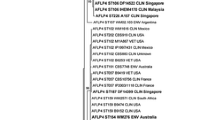Abstract
Vegetative cells of an ascomycetous yeast, morphologically consistent with published descriptions of Cyniclomyces guttulatus, were observed in large numbers in the feces and stomach washes of three dogs with a recurrent medical history characterized by vomiting and diarrhea. Nucleotide sequence analysis of an approximately 600 base pair fragment of the variable D1/D2 domain of large subunit (26S) ribosomal DNA of a pure culture, isolated from a Siberian Husky, revealed 98–99 % homology to sequences deposited in the GenBank as C. guttulatus. These data represent the first observation of C. guttulatus in association with canine gastrointestinal illness in the southern hemisphere and add weight to the hypothesis that this yeast may act as an opportunistic pathogen of dogs. An extended examination of wet mounts and smears prepared from feces collected from 63 dogs with no clinical symptoms of gastrointestinal illness, identified C. gluttulatus in 14 (22.2 %) of the animals, albeit at lower numbers than in diseased dogs, indicating that this yeast species is widely distributed as a component of the normal microflora of the canine gastrointestinal tract.

Similar content being viewed by others
References
Altschul SF, Gish W, Miller W et al (1990) Basic local alignment search tool. J Mol Biol 215:403–410
Birgel EH, Netto LP, Amaral V et al (1977) Meios e métodos de diagnóstico em Medicina Veterinária, 4a ed. Sociedade Paulista de Medicina Veterinária, São Paulo
Brito EH, Fontenelle RO, Brilhante RS et al (2009) The anatomical distribution and antimicrobial susceptibility of yeast species isolated from healthy dogs. Vet J 182:320–326
Cafarchia C, Otranto D (2004) Association between phospholipase production by Malassezia pachydermatis and skin lesions. J Clin Microbiol 142:4868–4869
Coutinho SDA (2005) Malassezia pachydermatis: enzymes production in isolates from external ear canal of dogs with and without otitis. Arq Bras Med Vet Zootec 57:149–153
Dijkstra M, Kraus JS, Bosje JT et al (2010) Protein-losing enteropathy in Rottweilers. Tijdschr Diergeneeskd 135:406–412
Ettinger SJ (1996) Manual de medicina Interna Veterinária, 1a ed. Editora Manole, São Paulo
Flausino G, Baroni FA (2009) Isolation of Cyniclomyces guttulatus (Robin) Van Der Walt and Scott (1971). Rev Bras Med Vet 31:100–103
Gjerde B, Holtet L, Sanden S et al (2009) Cyniclomyces guttulatus-lignende sopp som mulig ärsak til gastroenteritt hos hund—en kasusbeskrivelse. Norsk Veterinaer Tidsskrift 121:507–510
Hersey-Benner C (2008) Diarrhea in a rabbit. Cyniclomyces guttulatus yeast. Lab Animal (NY) 37:347–349
Houwers DJ, Blankenstein B (2001) Cyniclomyces guttulatus and diarrhea in dogs. Tijdschr Diergeneeskd 126:14–15
Kurtzman CP, Robnett CJ (1998) Identification and phylogeny of ascomycetous yeasts from analysis of nuclear large subunit (26S) ribosomal DNA partial sequences. Antonie Leeuwenhoek 73:331–371
Neel JA, Tarigo J, Grindem CB (2006) Gallbladder aspirate from a dog. Vet Clin Path 35:467–470
Peters S, Houwers DJ (2009) Een geval van diarree geassocieerd met Cyniclomyces guttulatus (brillendoosjesgist) bij de kat. Tijdschr Diergeneeskd 134:198–199
Phaff HJ, Miller MW (1999) Cyniclomyces Van Der Walt et Scott. In: Kurtz CP, Fell JW (eds) The Yeasts: a taxonomic study. Elsevier, Amsterdam, pp 154–156
Richle R, Scholer HJ (1961) Saccharomycopsis guttulata Von Kaninchen: Kulturelle Eigenschaften Und Mögliche Bedeatung. Pathol et. Microbiol 24:783–793
Rippon JW (1974) Medical Mycology: the pathogenic fungi and the pathogenic Actinomycetes. W.B. Saunders Co, Philadelphia
Saito K, Saito H, Watanabe T et al. (2009) Cyniclomyces guttulatus: it can now be clearly observed in canine feces. Saito Animal Hospital, M.B.Network, Kitasato Instiute. http://www33.ocn.ne.jp/~saitoahohp/Cyniclomyces.htm. Accessed on: Nov 3 2009
Sherding RG, Johnson SE (2008) Doenças intestinais. In: Birchard SJ, Sherding RG (eds) Manual Saunders de clínica de pequenos animais, 3a ed. Editora Rocca, São Paulo
Smith MT, Robert V, Poot GA et al (2005) Taxonomy and phylogeny of the ascomycetous yeast genus Zygoascus, with proposal of Zygoascus meyerae sp. nov. and related anamorphic varieties. Int J Syst Evol Microbiol 55:1353–1363
Zierdt CH, Detlefson C, Muller J et al (1988) Cyniclomyces guttulatus (Saccharomycopsis guttulata)-culture, ultrastructure and physiology. Antonie Leeuwenhoek 54:357–366
Author information
Authors and Affiliations
Corresponding author
Rights and permissions
About this article
Cite this article
Flausino, G., Leal, P.D.S., McIntosh, D. et al. Isolation and Characterization of Cyniclomyces guttulatus (Robin) Van Der Walt and Scott, 1971 in Dogs in Brazil. Curr Microbiol 65, 542–546 (2012). https://doi.org/10.1007/s00284-012-0184-6
Received:
Accepted:
Published:
Issue Date:
DOI: https://doi.org/10.1007/s00284-012-0184-6




